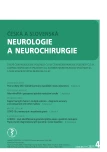CANVAS – a newly identified genetic cause of late-onset ataxia. Description of the first cases in the Czech Republic
Authors:
M. Danková 1; Z. Mušová 2; J. Jeřábek 1; J. Paulasová; Schwabová 1,3; A. Zumrová 3; E. Vyhnálková 2; S. Skalská 4; R. Mazanec 1; M. Vyhnálek 1
Authors place of work:
Centrum hereditárních ataxií, Neurologická, klinika 2. LF UK a FN Motol, Praha
1; Centrum hereditárních ataxií, Ústav, biologie a lékařské genetiky, 2. LF UK a FN Motol, Praha
2; Centrum hereditárních ataxií, Klinika, dětské neurologie 2. LF UK, a FN Motol, Praha
3; Neurologická klinika 1. LF UK a VFN, v Praze, Praha
4
Published in the journal:
Cesk Slov Neurol N 2021; 84/117(4): 397-402
Category:
Z klinické praxe
doi:
https://doi.org/10.48095/cccsnn2021397
Summary
Cerebellar ataxia, neuropathy, vestibular areflexia syndrome (CANVAS) is an autosomal recessive neurodegenerative disease from hereditary ataxias with a late onset that affects the cerebellum, sensory nerves, and the vestibular system. Its genetic cause was discovered in 2019 and since 2020, diagnostic molecular genetic testing has also been available. According to the existing literature, it seems that CANVAS is a major cause of late onset hereditary ataxia. Out of the first nine examined patients with the suspected disease, we confirmed four cases of CANVAS; three of the patients are described in detail in this manuscript.
Keywords:
Cerebellar ataxia – neuropathy – vestibulopathy – hereditary ataxias – CANVAS
Zdroje
1. Szmulewicz DJ, Waterston JA, Macdougall HG et al. Cerebellar ataxia, neuropathy, vestibular areflexia syndrome (CANVAS): a review of the clinical features and video-oculographic diagnosis. Ann N Y Acad Sci 2011; 1233 (1): 139–147. doi: 10.1111/j.1749-6632.2011.06 158.x.
2. Cortese A, Simone R, Sullivan R et al. Biallelic expansion of an intronic repeat in RFC1 is a common cause of late-onset ataxia. Nat Genet 2019; 51 (4): 649–658. doi: 10.1038/s41588-019-0372-4.
3. Migliaccio AA, Halmagyi GM, McGarvie LA et al. Cerebellar ataxia with bilateral vestibulopathy: description of a syndrome and its characteristic clinical sign. Brain 2004; 127 (2): 280–293. doi: 10.1093/brain/awh030.
4. Szmulewicz DJ, Roberts L, McLean CA et al. Proposed diagnostic criteria for cerebellar ataxia with neuropathy and vestibular areflexia syndrome (CANVAS). Neurol Clin Pract 2016; 6 (1): 61–68. doi: 10.1212/CPJ.000 0000000000215.
5. Wu TY, Taylor JM, Kilfoyle DH et al. Autonomic dysfunction is a major feature of cerebellar ataxia, neuropathy, vestibular areflexia „CANVAS“ syndrome. Brain 2014; 137 (10): 2649–2656. doi: 10.1093/brain/awu 196.
6. Cazzato D, Bella ED, Dacci P et al. Cerebellar ataxia, neuropathy, and vestibular areflexia syndrome: a slowly progressive disorder with stereotypical presentation. J Neurol 2016; 263 (2): 245–249. doi: 10.1007/s00415-015-7951-9.
7. Infante J, García A, Serrano-Cárdenas KM et al. Cerebellar ataxia, neuropathy, vestibular areflexia syndrome (CANVAS) with chronic cough and preserved muscle stretch reflexes: evidence for selective sparing of afferent Ia fibres. J Neurol 2018; 265 (6): 1454–1462. doi: 10.1007/s00415-018-88 72-1.
8. Cortese A, Tozza S, Yau WY et al. Cerebellar ataxia, neuropathy, vestibular areflexia syndrome due to RFC1 repeat expansion. Brain 2020; 143 (2): 489–490. doi: 10.1093/brain/awz418.
9. Hantash FM, Goos DM, Crossley B et al. FMR1 premutation carrier frequency in patients undergoing routine population-based carrier screening: insights into the prevalence of fragile X syndrome, fragile X-associated tremor/ataxia syndrome, and fragile X-associated primary ovarian insufficiency in the United States. Genet Med 2011; 13 (1): 39–45. doi: 10.1097/GIM.0b013e3181fa9fad.
10. Cortese A, Reilly MM, Houlden H. RFC1 CANVAS/Spectrum Disorder. [online]. GeneReviews 2020 Nov 25. Available from: https: //www.ncbi.nlm.nih.gov/books/NBK564656/.
11. Subramony SH. SARA – a new clinical scale for the assessment and rating of ataxia. Nat Clin Pract Neurol 2007; 3 (3): 136–137. doi: 10.1038/ncpneuro0426.
12. Campuzano V, Montermini L, Moltò MD et al. Friedreich’s ataxia: autosomal recessive disease caused by an intronic GAA triplet repeat expansion. Science 1996; 271 (5254): 1423–1427. doi: 10.1126/science.271.5254.1423.
13. Larsen PA, Hunnicutt KE, Larsen RJ et al. Warning SINEs: alu elements, evolution of the human brain, and the spectrum of neurological disease. Chromosom Res 2018; 26 (1–2): 93–111. doi: 10.1007/s10577-018-9573-4.
14. Agrawal Y, Van De Berg R, Wuyts F et al. Presbyvestibulopathy: diagnostic criteria Consensus document of the classification committee of the Bárány Society. J Vestib Res 2019; 29 (4): 161–170. doi: 10.3233/VES-190672.
Štítky
Dětská neurologie Neurochirurgie NeurologieČlánek vyšel v časopise
Česká a slovenská neurologie a neurochirurgie

2021 Číslo 4
Nejčtenější v tomto čísle
- Poruchy čichu po COVID-19 – diagnostika, význam a léčba
- Proč se dráhy kříží? Základní principy uspořádání mozku obratlovců
- CANVAS – nově identifikovaná genetická příčina ataxie s pozdním nástupem. Popis prvních diagnostikovaných pacientů v České republice
- COVID-19 asociovaná myelitida – kazuistika vzácné komplikace závažné SARS-CoV-2 infekce
